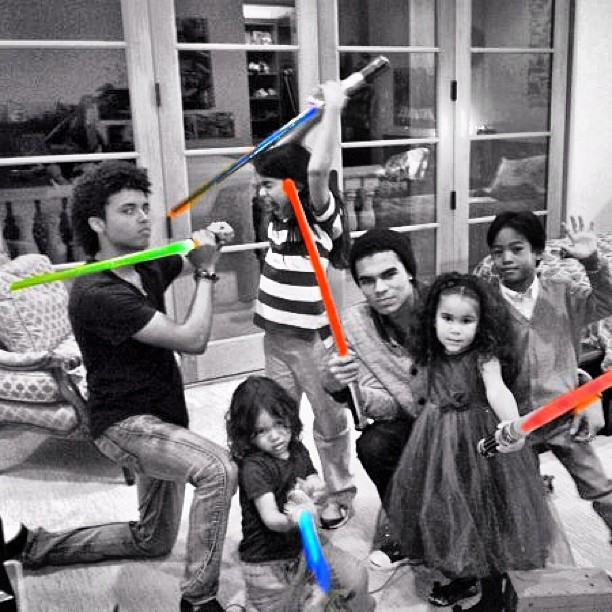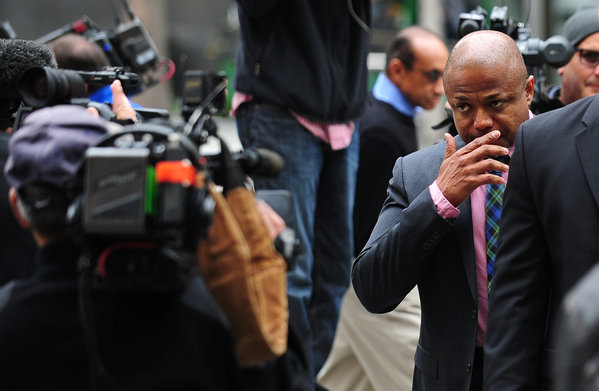Quelle: MJJC . Eintrag #4 . User: Ivy
http://www.mjjcommunity.com/forum/threads/129265-Katherine-Jackson-vs-AEG-Live-Daily-Trial-Testimony-SummaryJacksons vs AEG - Day 2 - April 30 2013 – Summary
 Original anzeigen (0,3 MB)
Original anzeigen (0,3 MB)
Katherine Jackson and Randy Jackson attended the second day of civil trial.
HearingCourt first addressed notes from 2 alternate jurors about availability. One alternate juror has a funeral to attend tomorrow and one alternate jury is moving out of state. The court will only be 1 hour tomorrow (end at 11:00) to accommodate the juror attending a funeral. The juror moving out of state will stay on the jury panel for now (AP).
AEG asked to exclude Randy Jackson from the courtroom because he is listed as a witness (AP). AEG attorney argued that there was "a risk in allowing any of them in the courtroom."(CNN). Jackson lawyer said Randy Jackson is supporting Katherine Jackson in the courtroom and should stay (AP) Jackson lawyer said Katherine needs one son or daughter to sit with her. (CNN)
The judge ordered that only one of Michael Jackson's brothers and sisters can come to court to watch the testimony at at a time -- and then only if Jackson family matriarch Katherine Jackson is present.(CNN)
Judge said “One is enough. He (Randy Jackson) can remain but you cannot have five in the courtroom” (CNN).Witnesses who aren’t parties generally aren’t allowed to listen to testimony.(AP)
Judge also told attorneys they have to tell her which witnesses are coming up, and how long their testimony is expected to last. (AP)
LAFD Paramedic Richard Senneff Testimony
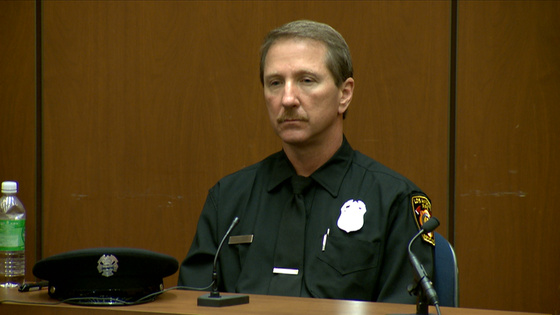
Richard Senneff had testified during Murray trial. Media reports suggest his testimony is very similar to his testimony at Murray criminal trial
Refresher: Link to Senneff’s testimony at Murray Criminal Trial :
http://www.mjjcommunity.com/forum/threads/129266-Jacksons-vs-AEG-Day-2-April-30-2013-Discussion/page2?p=3816642&viewfull=1#post3816642Katherine and Randy Jackson left the courtroom when Senneff began testifying (Multiple media)
Jackson DirectSenneff starts his testimony by telling the jurors what he does as a paramedic and explaind the different machines in a rescue ambulance (AP & ABC7) Senneff mentioned his experiences as a paramedic (AP).
Senneff is wearing his dress uniform, which he tells jury is for “special occasions.” Several jurors, audience members, laugh. Jackson’s lawyer Panish asks: “Have you ever rescued any cats in trees?” (AP)
"I have not rescued a cat," Senneff, who is also a firefighter, joked. "I rescued a dog that was lying in the street." (CNN)
Senneff also shared the ironic story of the next emergency he responded to after leaving MJ at the UCLA.His ambulance was called to a west Los Angeles apartment to help an elderly Russian woman."When she heard the news on TV that Michael Jackson had died, she fainted," he said. She suffered a minor head injury in her fall."She was just deeply emotional when we took her to the hospital," Senneff said. (CNN)
Timeline of paramedics' response, PT
12:22p - dispatched
12:23- rolling down the street
12:25- on scene
13:07 - transported
13:13 – hospital
Senneff stated on June 25, 2009 he responded to a patient not breathing. Senneff said he arrived at MJ's house at 12:25 pm PT and got out of the ambulance with their equipment, EKG monitor, needles, and medicine. (ABC7)
Senneff testified Station 71 in Bel-Air had received the emergency call at 12:22 p.m. and he arrived at MJ's home three minutes later. The ambulance and a fire engine that responded were waved through the gates and parked in front of the house (LATimes).
Once in the house, Senneff said, he was "galloping" up the stairs.(LATimes). Senneff says he was the first paramedic inside MJ’s bedroom (AP).
Senneff saw Murray near the nightstand with a security guard, and MJ lying on the bed.(LATimes) Senneff: He was leaning over the patient, patient laying on the bed, Murray standing there and they were moving the patient to the floor (ABC7)
Senneff told he noticed oxygen tanks, an IV pole and an IV bag in the room, along with Dr. Conrad Murray, who he said told him that he was a cardiologist (LATimes). Senneff told the panel he found an IV pole, oxygen tanks and a nightstand with several medicine bottles on the nightstand. (AP & ABC7)
“Even in Bel-Air it’s unusual to have the personal physician at the house,” Senneff testified. (LATimes)
Senneff: I saw a patient wearing pajama pants and shirt, and some surgical cover over the head. He looked very pale, very weak. (ABC7) Senneff testified MJ’s body was pale and so underweight his ribs were showing.(LATimes)
Senneff said "The patient appeared to be chronically ill to me. He was very pale and underweight. I thought perhaps this was a hospice patient." (Reuters)
Senneff said “To me, he looked like someone who was at the end stage of a long disease process,” (LATimes)
Because of what he saw, Senneff asked Murray if MJ had a “do not resuscitate” order.
"Dr. Murray loked at me blankly at first," Senneff testified. Then the doctor said, "No, no, this just happened."(LATimes)
Senneff said Murray was "frantic.(LATimes)
“He was pale, he was sweating, he was very busy," Senneff said of Murray (Reuters)
Senneff said Murray told him he was treating the patient for dehydration and exhaustion and said Jackson was not taking any medication.(LATimes) Senneff testified that Murray never told him about Propofol (Reuters)
Senneff: "I asked what his underlying condition was.... the doctor said nothing, that he was just treating him for dehydration & exhaustion" (ABC7)
"It just looked a lot more complicated than dehydration and exhaustion," Senneff testified. (LATimes)
Senneff asked what kind of medication patient was taking. Senneff said that according to Dr. Murray, "he was not" (taking any medication) (ABC7)
When he asked Murray when the emergency had happened, he said Murray told him: "Just this minute. Right when I called you.”(LATimes)
Senneff said when he moved MJ, he felt he did not have a pulse. His pupils were fixed and dilated, eyes were quite dried (ABC7).
But when Senneff checked Jackson, he said he could find no pulse. He testified that Jackson’s eyes were dilated and dry, his skin cool, and his lips a faint blue – a sign the singer had been dead as long as an hour.(LATimes) Senneff said MJ's chest was pale white, his hands and feet turned blue from not getting enough ventilation/oxygen.(ABC7) MJ's blue hands, feet and lips, and the singer's dry eyes all signaled to Senneff that MJ was dead and hadn't been breathing for a long time.(AP)
Senneff: "When I picked him up and moved him, he was cool to the touch. I would say less than an hour... Body doesn't get cold that fast"(ABC7)
“To us it didn’t make sense that it had just happened,” Senneff said.(LATimes)
Senneff was asked whether he thought MJ was dead when he arrived at his home. Senneff said yes. (AP)
Jackson family attorney: "He was dead before you got there, wasn't he?" Senneff: "Yes, sir." (LATimes)
Senneff said he contacted UCLA hospital. He also said Dr. Murray then indicated he gave MJ a little bit of lorazepam to help him sleep(ABC7)
Senneff: "I notified the hospital and was told to continue resuscitation efforts."(ABC7)
Senneff testified a paramedic was using the ambu bag to breath for the patient, another connecting the EKG machine and was giving him drugs. As for Dr. Murray, he was trying to help the best he could, Senneff said, and that the doctor "was looking for things in the box". (ABC7)
Senneff: "Dr Murray reached in our box, he gave additional injection of epinephrine (ABC7)
Senneff testified Murray said he felt femoral artery pulse. However, Senneff said no one else, other than Murray, was able to find a pulse. MJ's condition hadn't changed on the way to the hospital.(ABC7)
Senneff "The hospital asked me about calling (time of death). Murray said no."(ABC7)
Murray looked like "a deer in the headlights" when paramedic Seneff went back into MJ's room to gather his equipment (LATimes)
Senneff: Murray had a white plastic bag in one hand. When I came to the door he froze, he was actually surprised to see me (in MJ's room)(ABC7)
Senneff testified Murray rode in the ambulance together. He was standing in the ambulance, holding the top rail, talking on the cell phone. (ABC7)
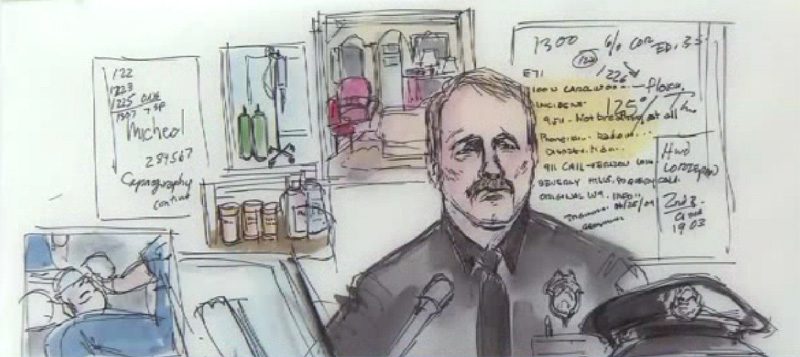
It was chaotic outside the house, very difficult to get out. People trying to take pictures, unbelievable amount of commotion. Senneff was shown a picture of MJ inside the ambulance and confirmed it was legit.(ABC7)
Upon arrival at UCLA, Senneff explained to the ER doctor what he had done, like a quick recap, no changes in patient's status. (ABC7)
Senneff said initially he was not able to identify the patient, but as it progressed someone said his name was MJ.
Senneff: "Once someone said his name, I looked at the patient's face and saw it was Michael Jackson."(ABC7)
AEG crossAEG cross was done by Kathryn Cahan.
AEG Lawyer Cahan: "No one on your team detected pulse? Senneff: No
AEG lawyer Cahan: Was he dead for a period of time? Senneff: Yes" (ABC7)
AEG lawyer asked Senneff if he thought Murray was not telling him the truth."I don't even go there," Senneff said. "I'm not worried about that."(CNN)
AEG lawyer Cahan: Did Murray lied to you? Senneff: I'm not even going there. I was worried about the patient and all the info I can get. (ABC7)
Senneff said he let Murray go through his medical bag since what he was doing was reasonable (ABC7)
Senneff testified it is not unusual for family members, people around the patient not know whether they are taking drugs (ABC7)
Cahan went through the emergency medical service report again. It asks the weight of the patient, Senneff estimated 150lbs, 5'09-ish. Senneff answers 120 calls per month average. He said he got very good at estimating people's weight.(ABC7)
When Senneff asked Murray about MJ's underlying condition: "He said nothing, nothing, I'm just treating him for dehydration, exhaustion."(ABC7)
AEG’s lawyer asked Senneff about his knowledge of propofol. Senneff told her that he knew propofol was a general anesthesia, but had never seen it used. (AP) As to Propofol, Senneff said all he knew it was an anesthetic used in surgeries. He learned through the media that was MJ's cause of death (ABC7)
Jackson re-directSenneff told he did not see Dr. Murray actually performing CPR.(ABC7)
Senneff said the American Heart Association indicates CPR is performed on a bed it's less desirable. One must place patient on hard surface. Panish said Dr. Murray performed CPR with Michael Jackson on the bed: "That's not how you're supposed to do it," Senneff opined.(ABC7)
Panish asked Senneff whether he thought Conrad Murray was competent to perform CPR. Senneff said he didn’t believe Conrad Murray was competent enough to perform CPR (AP)
As to Dr. Murray, Senneff said: "I did not believe he was telling me the full story at the time." (ABC7)
Panish: What did Michael Jackson tell you?
Senneff: Nothing, sir
Panish: Because he was dead when you arrived?
Senneff: Yes, sir (ABC7)
Senneff agreed that it is expected that a competent, fit physician be able to revive a patient in respiratory arrest.(ABC7)
LAPD Detective Orlando Martinez Testimony
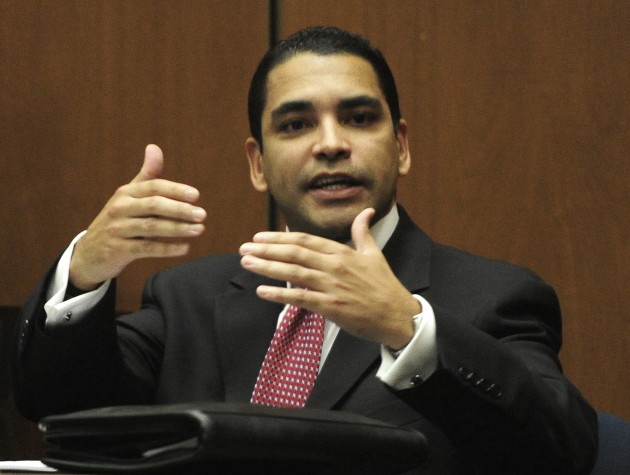
Jackson directMartinez started by explaining his training and background. Martinez learned from his lieutenant that Michael Jackson was the victim. He went to UCLA to begin his investigation. (ABC7)
Martinez said he saw Frank Dileo and Randy Phillips at the hospital as well as Katherine and Randy Jackson and MJ’s kids (ABC7)
Jackson's lawyer Panish: Were you able to speak with Dr. Murray at the UCLA?
Martinez: No
Panish: Why not?
Martinez: He had left (ABC7)
At the hospital, LAPD officers decided to fly MJ’s body to the coroner’s officer so that the transport wouldn't become a spectacle.(AP)
Martinez then went to MJ’s house at Carolwood. Martinez photographed the scene (AP). Lots of photographs were shown to the jurors. Martinez explained the photographs to the jurors. He also mentioned that police made three separate trips to MJ’s home to collect evidence.(AP)
Martinez didn't search Murray's vehicle because he wanted a search warrant. Martinez didn't leave Murray's car at the residence, wanted a reason for the doc to go talk to him. Car was impounded to a police yard (ABC7).
Inside the BMW -- which was registered to Murray's sister in Texas -- he found a contract between AEG Live and Murray saying he would be paid $150,000 a month to work as Jackson's doctor, along with AEG Live President Randy Phillips' business card and cell phone number, he said.(CNN) In Murray's car: handwriten note with 24 hour pharmacies names/numbers; Randy Phillips' business card; contract between Dr. Murray and AEG (ABC7)
The detective said that when he interviewed Murray with two attorneys present, the doctor made up a story to protect himself.
“He was not being honest and forthright,” Martinez testified. (LATimes)
Martinez had already interviewed Dr. Murray prior to the car's search. He attempted to interview him again, but doc wasn't talking anymore (ABC7) Martinez said he was looking for a motive for MJ's death, and the contract could be important financial aspect to investigate.(ABC7)
Seeing pictures of MJ's room, Martinez said he saw IV bag, pill bottles, vials, ambu bag. "It looked like the room had been cleaned up," he said. Martinez: "Things had been removed from the room prior to police's arrival." He took several pictures to document the scene. (ABC7) Martinez says he learned from Dr. Murray that there were 3 bags total of medicine in the closet. He went back to the house to retrieve them. Martinez took fingerprints off the bags and found Dr. Murray's prints on the bottles.(ABC7) (Jurors were shown several pictures of evidence collected and crime scene photos)
Det. Orlando Martinez at first concluded that the cause was accidental or natural. (LATimes) Martinez said at that time the investigation was leading to natural or accidental death, no real signs of foul play, but it was odd.(ABC7)
LAPD Detective Orlando Martinez's testimony focused on Murray's finances as a potential motive for his treatment of Jackson. (AP)
When Martinez discovered the deep financial straits Murray, he shifted his thinking and pondered whether he had discovered a motive for the pop star’s death — “financial gain.” (LATimes)
Martinez told jurors Murray was more than $500,000 in debt and may have been motivated by a large payday for working with MJ.(AP)
Detective Martinez testified that after interviewing Murray and after the search of Murray's car four days after MJ's death, his "thinking at the moment was the crime was negligence." (CNN)
Detective Orlando Martinez testified that he looked into Murray's finances searching for a financial motive for his role in Jackson's death and relied mostly on public records. He turned up that Murray's Las Vegas home was in foreclosure proceedings, and Murray faced several liens for unpaid child support and other unpaid debts.(AP)
His investigation revealed that Murray hadn't paid his mortgage in more than six months, his home was being foreclosed on and he had several liens for unpaid child support and tax debts, Martinez said.(CNN)
Murray's Las Vegas home, which he bought for $1.6 million, was appraised at barely $1 million in 2009, he said. The Las Vegas real estate market had suffered a major decline in home values up to that date.(CNN) The house was in foreclosure (LATimes)
Martinez checked Dr. Murray's credit report. "There was a notice up that his house was either on a lien or being foreclosed on." (ABC7)
Panish showed a document from a title company that said Dr. Murray owed $ 1,644,644.25 for the loan of his house (unpaid principal balance) (ABC7)
As of January 2009, Dr. Murray had not been paying his mortgage and was behind $ 15,165.11. Late charges accruing at rate of $3,477.95 (ABC7)
Martinez says he determined the doctor was more than $500,000 in debt, facing foreclosure and his “office was about to be closed.”(AP)
Murray had closed his office to work with one patient — Jackson, tying his financial future to him, Martinez said. (LATimes)
Orlando Martinez testified that Murray was trying to deal with the large drop in value of his Las Vegas home, unpaid taxes and child support payments for eight children with seven women.(CNN)
The searches led Martinez to conclude that Murray's financial condition was "severely distressed."(AP)
Panish: “Is there any question in your mind that Dr. Murray was in dire financial straits?” Martinez: “No, there was no question.” (AP)
"That's a lot of money for anyone," Martinez said. "Seeing the scene and talking to him about what he had done and how he did it raised questions."(CNN)
Martinez said that led him to believe Murray's actions were motivated by the $150,000 a month he expected to be paid by AEG.(AP)
"Focusing on the financial aspect may have been important for Dr. Murray's willingness to disregard his Hippocratic Oath for financial gain," he testified.(CNN)
Martinez said what he learned about Murray's financial troubles led him "to opine that he may have, for this easy money -- the $150,000 a month -- may break the rules, bend the rules, to do whatever he needed to do to get paid."(CNN)
"He may break the rules, bend the rules, do whatever he needed to do to get paid," Martinez said. "It might solve his money problems." (AP)








